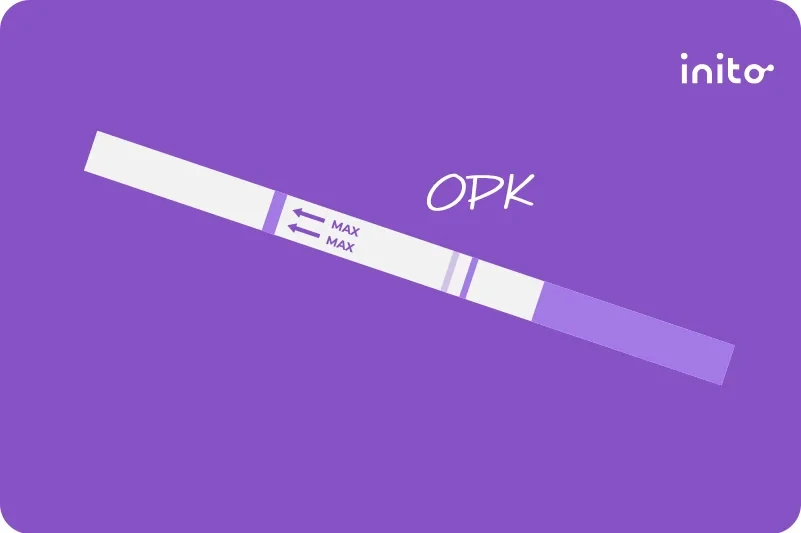Content table
Lots of women find that the length of their cycle does not align with the “typical” and expected 28 days. And in the same vein, we are all led to believe that 28 days is the length of a normal cycle. But the truth is that a cycle is still considered “normal” if it’s between 21 and 35 days long.
Some studies dive into that, and the results are interesting and worth sharing. One such study found that the median length of a woman’s menstrual cycle drops by about one day once you hit the age of 40.
So if this sounds like you, you’re likely asking, “Is a shorter menstrual cycle a problem?”
The short and sweet answer is “no” it is normal to have shorter cycles as you get older.
But, if you’re younger than 40, you’ll want to take a look at some things that may be causing your menstrual cycle to shorten early.
And that’s exactly what we are diving into today. Read on to learn more about your menstrual cycles getting closer together.
The menstrual cycle
Let’s start with covering some of the basics so that we are all on the same page. As mentioned above, a normal cycle can be anywhere between 21-35 days long.
It’s important to understand the difference between the term “length” and the term “duration.” They are often used interchangeably when talking about women’s cycles. Thankfully, we are here to fill you in on the fact that they are not the same.
The length of a cycle refers to the total length of a menstrual cycle and includes all the different phases in a cycle.
The duration of a cycle refers to the duration of bleeding in each cycle, which averages about 2-8 days.
Your hormones during the menstrual cycle
Now that we’ve cleared that up, it’s time to chat about what exactly goes on with your hormones during the menstrual cycle.
(And if this is news to you, don’t be embarrassed – so many women don’t fully understand their menstrual cycles.)
A woman’s menstrual cycle can be divided into two phases: the preovulatory phase and the postovulatory phase.
The preovulatory phase starts the day you start bleeding and marks the first day of your cycle. This phase continues until the day of ovulation.
Here’s a look at what happens with your hormones during the preovulatory phase, a.k.a. the follicular phase.
Follicle-stimulating hormone (FSH) triggers the follicles in the ovary to get ready to release the egg and ovulate.
- Once the dominant follicle is ready, it sends a hormone signal to the brain, letting it know that it’s mature.
- The dominant follicle then starts producing estrogen.
- Estrogen rises 3-4 days prior to ovulation and, in doing so, suppresses the body’s secretion of FSH.
- After estrogen levels are high for 48 hours, the brain signals for your luteinizing hormone (LH) levels to increase.
- This surge of LH in your body triggers ovulation, which occurs within 24-36 hours of the LH surge and around 12-14 days before your next period.
Once ovulation happens, your cycle moves into the postovulatory phase, a.k.a. the luteal phase.
Here’s what to expect hormonally during this luteal phase.
- Progesterone rules in this phase. This is the hormone that confirms ovulation.
- The high progesterone levels help nourish the uterine lining to prepare your body for a potential pregnancy.
- The egg released when you ovulate travels through the fallopian tube and down your uterus into the cervical canal.
- If sperm is in your body during ovulation, it meets with the egg to fertilize it. And if fertilization occurs, then you get pregnant and your progesterone rises. If fertilization does not happen, then your period happens and progesterone drops.
A shorter menstrual cycle
Now that you’re in sync with your understanding of the menstrual cycle, let’s get into the meat of this discussion: a shorter menstrual cycle and what it means.
First, let’s talk about the two different types of short cycles:
- Short follicular phase (less than 16 days). This occurs when both FSH and estrogen levels are lower than normal. This can lead to early ovulation.
- Short luteal phase (less than 11 days). This occurs when progesterone levels are low. This lack of progesterone can lead to luteal phase defects. This can lead to issues with getting or staying pregnant because the uterus isn’t prepping the body for pregnancy like it should.
You must now be wondering how to avoid short menstrual cycles that can cause issues. Which takes you back to the question, “Why is my menstrual cycle getting shorter?”
The main cause of shorter cycles is hormone imbalance. You’d be amazed to learn how much your hormones affect your life in many different ways.
In fact, let’s talk about some of the factors that affect hormones and, thus, affect the length of your menstrual cycle.
Factors that affect the length of your menstrual cycle
Age
As spoken above, as you age, it is normal to expect your menstrual cycle to shorten.
If you’re between 25 and 45 years old, you can see your cycle length shorten by 3.2 days. That means that your average follicular phase length shortens by 3.4 days.
Once you reach your mid to late-40s and above, your cycle length can be all over the place.
That’s because aging leads to a decrease in both estrogen and progesterone levels. Once the levels of these two hormones reach a certain low and ovulation ceases to exist, you enter into menopause.
Perimenopause
Speaking of menopause … perimenopause is the time when your body starts to transition to menopause. This means that your estrogen and progesterone levels drop, and you may have cycles where you don’t ovulate at all.
You may also find yourself dealing with symptoms that feel like menopause, including:
- Hot flashes
- Sleep struggles
- Vaginal dryness
Polycystic Ovary Syndrome (PCOS)
Chances are good you’ve heard of PCOS, but may not be totally sure what it is. Don’t worry – we’ve got you covered. PCOS is a condition that occurs when female hormones are imbalanced and affect the way that a woman’s ovaries work.
How is PCOS diagnosed?
It’s based on something called the Rotterdam criteria. You are diagnosed with PCOS if you meet two of these 3 criteria:
- Irregular periods or no ovulation
- Elevated male hormone levels (a.k.a. androgens)
- Cysts in the ovaries on an ultrasound scan
Along with the high levels of androgens, people with PCOS also experience high levels of FSH and LH, which causes high estrogen levels. Studies show that healthy women have an LH to FSH ratio of 1:2, but with PCOS, that reverses to 2:1 or even 3:1. Because of this increased LH:FSH, ovulation may not occur.
Primary ovarian insufficiency
This condition happens when your ovaries stop doing their job before you reach the age of 40. This means that your ovaries aren’t producing normal levels of estrogen, and instead, your body has high levels of FSH.
What does high levels of FSH mean? It means that your pituitary gland isn’t releasing enough LH, which can lead to anovulatory cycles. These are cycles where your body doesn’t ovulate. Anovulation is the number one cause of infertility.
To know more about Anovulation click here.
Thyroid disorders
Studies show that thyroid diseases happen more often in women and that these thyroid disorders can lead to issues, including a shortened menstrual cycle. How does this happen?
Well, these thyroid issues can come in the form of either hyperthyroidism or hypothyroidism.
Hyperthyroidism happens when your thyroid gland makes too much thyroid hormone. This means your thyroid-stimulating hormone (TSH) is low. (We know – it seems like it should be the opposite, but we promise it’s not.)
That’s because the job of the thyroid hormones is to suppress the level of TSH, and when high levels of thyroid hormones happen, it can cause low TSH levels.
Hypothyroidism happens when your thyroid isn’t making enough thyroid hormones and your TSH levels are too high. This means high estrogen, low FSH, and low LH. And that leads to anovulatory cycles.
Endometriosis
This painful disorder happens when the tissue that typically sits inside your uterus starts to grow outside your uterus. As you can imagine, this can lead to painful periods and shortened menstrual cycles, as well as potential infertility.
That’s because when you have endometriosis, your estrogen levels are high, and that can affect your cycle in a myriad of ways.
Fibroids
“What are fibroids?” you may be asking. They are tumors that develop in the uterus. Research guesses that 70-80% of women will develop fibroids at some point in their lives, but most won’t develop symptoms or need any sort of treatment.
But, fibroids can affect some women more, especially when it comes to the length of their menstrual cycle. That’s because fibroids can result in high estrogen levels, which, as you now know, can throw off your cycle length and cause a shorter cycle.
Read More: Fibroids: Can I get pregnant with a fibroid and if so, how?
Weight
Another thing that can shorten your menstrual cycle is abnormal weight – both low and high body weight.
Studies show that as fat levels increase in the body, so do estrogen levels. And those increased estrogen levels can cause irregular menstrual cycles.
Low body weight can also affect your cycle length. Being underweight can seriously affect your hormones and can even cause a drop in your estrogen levels. What happens in this case? Your ovulation gets off-track and can cause you to miss your period.
Medication
Certain medications can seriously affect your hormone levels, especially ones for anxiety and epilepsy. Always talk to your doctor about how any medication you’re taking can affect your hormone levels and, thus, your menstrual cycle length.
Stress
As if you didn’t already have enough reasons to hate stress, let’s throw hormone imbalance into the mix. Studies show that extreme stress can wreak havoc on our hormones, thanks to the fact that your body starts overproducing cortisol.
That cortisol spike increases prolactin and reduces estrogen levels, which makes your bodies (and menstrual cycles) all sorts of confused.
Increased cortisol also reduces progesterone levels in your body leading to shorter cycles.
Low progesterone
Your body can produce lower levels of progesterone due anovulatory cycles, PCOS, increased stress, high prolactin levels, low cholesterol levels, hypothyroidism, perimenopause, overexercising and poor eating habits. Low progesterone levels tend to reduce the length of your luteal phase resulting in shorter cycles.
Luteal phase defects happen when progesterone is low. What happens in this case? You experience shorter cycles.
Miscarriage
A miscarriage is a pregnancy loss that happens before you’ve reached 20 weeks. As you can imagine, this can wildly disrupt hormones which can lead to shifts in the length of the menstrual cycle.
Breastfeeding
This may come as a surprise, but nursing a baby actually causes your body to produce extra prolactin.
What does this extra prolactin do?
It actually results in low levels of estrogen and progesterone (the hormones that signal your body to ovulate.)
This means that at the start of breastfeeding, your body skips ovulation.
As you breastfeed less and less, your menstrual cycle will come back but will likely be shorter until you’re totally done breastfeeding.
Should you be worried about your short menstrual cycles?
If you find that your menstrual cycles vary in length a bit, don’t worry – especially if you are in your late 30s and early 40s or are postpartum.
But, if you start to notice some of these symptoms, then it’s time to schedule an appointment with your healthcare provider:
- Your menstrual cycle is regularly less than 21 days
- Your menstrual cycle is regularly longer than 35 days
- You have spotting or bleeding between your periods
- You bleed for more than 8 days during your period
- You bleed after menopause
- Your period is excessively heavy (meaning you bleed through a tampon every 1-2 hours)
- You feel dizzy or lightheaded
Can you get pregnant with short menstrual cycles?
The good news is, yes! It is possible to get pregnant even though you have short menstrual cycles.
However, there is a side note to this: your ability to get pregnant depends on two things:
- The type of short cycle (whether it’s short follicular or short luteal phase cycles as we talked about above)
- The cause of the short cycles
Once you address the reason that your menstrual cycles are short, you increase your chances of getting pregnant. The best way to get pregnant with shorter cycles is to track your cycles. This will help you track your fertile window and know the best days to get pregnant.
Track your cycles
To keep an eye on your hormone levels and your menstrual cycle, it’s a good idea to use the Inito Fertility Monitor. This allows you to track the actual values of estrogen, LH, FSH, and PdG (a urine metabolite of progesterone) with just one test.
This will help you better understand your hormones and whether you should worry about your menstrual cycle getting shorter.
Was this article helpful?
- Effect of hypothyroidism on female reproductive hormones – PMC
- Role of Estrogen in Thyroid Function and Growth Regulation – PMC
- Follicle Stimulating Hormone (LH: FSH) Ratio in Polycystic Ovary Syndrome (PCOS) – Obese vs. Non- Obese Women.
- Estrogen Receptors in Polycystic Ovary Syndrome – PMC
- Serum Thyrotropin and Phase of the Menstrual Cycle – PMC.
- Estrogen Receptors and Endometriosis – PMC
- Stress and behaviorally induced reproductive dysfunction in primates
- Stress and hormones – PMC












